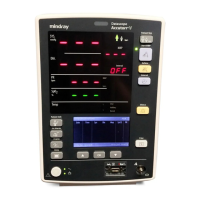Accutorr V Operating Instructions 0070-10-0699-02 6 - 7
Appendix Specifications
Pulse Rate
Pulse Rate During No Motion
Conditions
1
:
Adult/Pediatric/Neonates: 25 – 240 BPM ±3 digits
Pulse Rate During Motion
Conditions
2,3
:
Adult/Pediatric/Neonates: 25 – 240 BPM ±5 digits
Update Rate: 1 second
Wavelength of light emitted by the
sensors
red: 660 nm
infrared 940 nm
1 The Masimo MS-2013 pulse oximeter with LNOP- Adt sensors have been validated for no motion
accuracy in human blood studies on healthy adult volunteers in induced hypoxia studies in the
range of 70% to 100% SpO
2
against a laboratory co-oximeter and ECG monitor. This variation
equals plus or minus one standard deviation. Plus or minus one standard deviation encompasses
68% of the population.
2 The Masimo MS-2013 pulse oximeter with LNOP- Adt sensors has been validated for motion accu-
racy in human blood studies on healthy adult volunteers in induced hypoxia studies while per-
forming rubbing and tapping motions at 2 to 4 Hz. At an amplitude of 1 to 2 cm and non-
repetitive motion between 1 to 5 Hz. At an amplitude of 2 to 3cm in induced hypoxia studies in
the range of 70% to 100% SpO
2
against a laboratory co-oximeter and ECG monitor. This variation
equals plus or minus one standard deviation. Plus or minus one standard deviation encompasses
68% of the population.
3 The Masimo MS-13 pulse oximeter with LNOP-Neo and Neo Pt sensors have been validated for
neonatal motion accuracy in human blood studies on neonates while moving the neonate’s foot
at 2 to 4 Hz at an amplitude of 1 to 2 cm against a laboratory co-oximeter and ECG monitor. This
variation equals plus or minus one standard deviation. Plus or minus one standard deviation
encompasses 68% of the population
4 The Masimo MS-13 pulse oximeter has been validated for low perfusion accuracy in bench top
testing against a Biotek Index 2 simulator and Masimo’s simulator with signal strengths of
greater then 0.02% and a % transmission of greater than 5% for saturation’s ranging from 70 to
100%. This variation equals plus or minus one standard deviation. Plus or minus one standard
deviation encompasses 68% of the population.

